Paul Bogdan
MaskAttn-SDXL: Controllable Region-Level Text-To-Image Generation
Sep 18, 2025Abstract:Text-to-image diffusion models achieve impressive realism but often suffer from compositional failures on prompts with multiple objects, attributes, and spatial relations, resulting in cross-token interference where entities entangle, attributes mix across objects, and spatial cues are violated. To address these failures, we propose MaskAttn-SDXL,a region-level gating mechanism applied to the cross-attention logits of Stable Diffusion XL(SDXL)'s UNet. MaskAttn-SDXL learns a binary mask per layer, injecting it into each cross-attention logit map before softmax to sparsify token-to-latent interactions so that only semantically relevant connections remain active. The method requires no positional encodings, auxiliary tokens, or external region masks, and preserves the original inference path with negligible overhead. In practice, our model improves spatial compliance and attribute binding in multi-object prompts while preserving overall image quality and diversity. These findings demonstrate that logit-level maksed cross-attention is an data-efficient primitve for enforcing compositional control, and our method thus serves as a practical extension for spatial control in text-to-image generation.
H$^2$GFM: Towards unifying Homogeneity and Heterogeneity on Text-Attributed Graphs
Jun 10, 2025Abstract:The growing interests and applications of graph learning in diverse domains have propelled the development of a unified model generalizing well across different graphs and tasks, known as the Graph Foundation Model (GFM). Existing research has leveraged text-attributed graphs (TAGs) to tackle the heterogeneity in node features among graphs. However, they primarily focus on homogeneous TAGs (HoTAGs), leaving heterogeneous TAGs (HeTAGs), where multiple types of nodes/edges reside, underexplored. To enhance the capabilities and applications of GFM, we introduce H$^2$GFM, a novel framework designed to generalize across both HoTAGs and HeTAGs. Our model projects diverse meta-relations among graphs under a unified textual space, and employs a context encoding to capture spatial and higher-order semantic relationships. To achieve robust node representations, we propose a novel context-adaptive graph transformer (CGT), effectively capturing information from both context neighbors and their relationships. Furthermore, we employ a mixture of CGT experts to capture the heterogeneity in structural patterns among graph types. Comprehensive experiments on a wide range of HoTAGs and HeTAGs as well as learning scenarios demonstrate the effectiveness of our model.
HDLCoRe: A Training-Free Framework for Mitigating Hallucinations in LLM-Generated HDL
Mar 18, 2025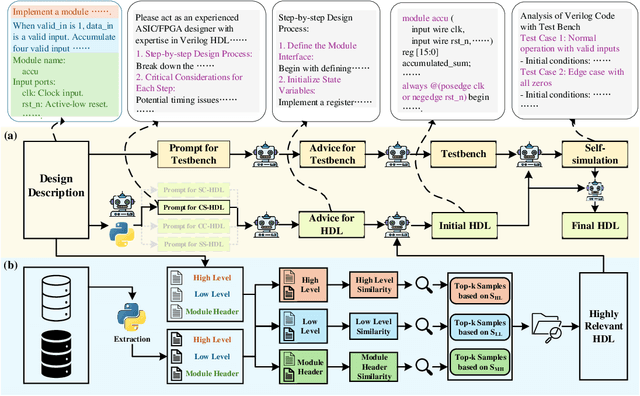



Abstract:Recent advances in large language models (LLMs) have demonstrated remarkable capabilities in code generation tasks. However, when applied to hardware description languages (HDL), these models exhibit significant limitations due to data scarcity, resulting in hallucinations and incorrect code generation. To address these challenges, we propose HDLCoRe, a training-free framework that enhances LLMs' HDL generation capabilities through prompt engineering techniques and retrieval-augmented generation (RAG). Our approach consists of two main components: (1) an HDL-aware Chain-of-Thought (CoT) prompting technique with self-verification that classifies tasks by complexity and type, incorporates domain-specific knowledge, and guides LLMs through step-by-step self-simulation for error correction; and (2) a two-stage heterogeneous RAG system that addresses formatting inconsistencies through key component extraction and efficiently retrieves relevant HDL examples through sequential filtering and re-ranking. HDLCoRe eliminates the need for model fine-tuning while substantially improving LLMs' HDL generation capabilities. Experimental results demonstrate that our framework achieves superior performance on the RTLLM2.0 benchmark, significantly reducing hallucinations and improving both syntactic and functional correctness.
End-to-End Learning Framework for Solving Non-Markovian Optimal Control
Feb 07, 2025Abstract:Integer-order calculus often falls short in capturing the long-range dependencies and memory effects found in many real-world processes. Fractional calculus addresses these gaps via fractional-order integrals and derivatives, but fractional-order dynamical systems pose substantial challenges in system identification and optimal control due to the lack of standard control methodologies. In this paper, we theoretically derive the optimal control via \textit{linear quadratic regulator} (LQR) for \textit{fractional-order linear time-invariant }(FOLTI) systems and develop an end-to-end deep learning framework based on this theoretical foundation. Our approach establishes a rigorous mathematical model, derives analytical solutions, and incorporates deep learning to achieve data-driven optimal control of FOLTI systems. Our key contributions include: (i) proposing an innovative system identification method control strategy for FOLTI systems, (ii) developing the first end-to-end data-driven learning framework, \textbf{F}ractional-\textbf{O}rder \textbf{L}earning for \textbf{O}ptimal \textbf{C}ontrol (FOLOC), that learns control policies from observed trajectories, and (iii) deriving a theoretical analysis of sample complexity to quantify the number of samples required for accurate optimal control in complex real-world problems. Experimental results indicate that our method accurately approximates fractional-order system behaviors without relying on Gaussian noise assumptions, pointing to promising avenues for advanced optimal control.
Network-informed Prompt Engineering against Organized Astroturf Campaigns under Extreme Class Imbalance
Jan 21, 2025Abstract:Detecting organized political campaigns is of paramount importance in fighting against disinformation on social media. Existing approaches for the identification of such organized actions employ techniques mostly from network science, graph machine learning and natural language processing. Their ultimate goal is to analyze the relationships and interactions (e.g. re-posting) among users and the textual similarities of their posts. Despite their effectiveness in recognizing astroturf campaigns, these methods face significant challenges, notably the class imbalance in available training datasets. To mitigate this issue, recent methods usually resort to data augmentation or increasing the number of positive samples, which may not always be feasible or sufficient in real-world settings. Following a different path, in this paper, we propose a novel framework for identifying astroturf campaigns based solely on large language models (LLMs), introducing a Balanced Retrieval-Augmented Generation (Balanced RAG) component. Our approach first gives both textual information concerning the posts (in our case tweets) and the user interactions of the social network as input to a language model. Then, through prompt engineering and the proposed Balanced RAG method, it effectively detects coordinated disinformation campaigns on X (Twitter). The proposed framework does not require any training or fine-tuning of the language model. Instead, by strategically harnessing the strengths of prompt engineering and Balanced RAG, it facilitates LLMs to overcome the effects of class imbalance and effectively identify coordinated political campaigns. The experimental results demonstrate that by incorporating the proposed prompt engineering and Balanced RAG methods, our framework outperforms the traditional graph-based baselines, achieving 2x-3x improvements in terms of precision, recall and F1 scores.
Multi-scale Generative Modeling for Fast Sampling
Nov 14, 2024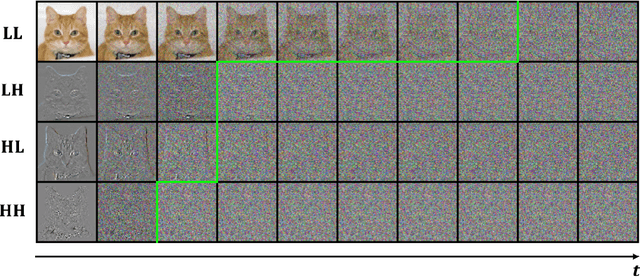

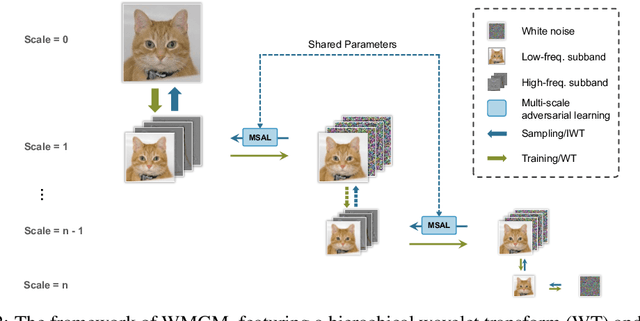
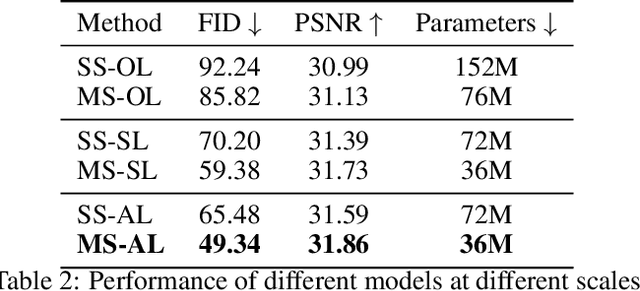
Abstract:While working within the spatial domain can pose problems associated with ill-conditioned scores caused by power-law decay, recent advances in diffusion-based generative models have shown that transitioning to the wavelet domain offers a promising alternative. However, within the wavelet domain, we encounter unique challenges, especially the sparse representation of high-frequency coefficients, which deviates significantly from the Gaussian assumptions in the diffusion process. To this end, we propose a multi-scale generative modeling in the wavelet domain that employs distinct strategies for handling low and high-frequency bands. In the wavelet domain, we apply score-based generative modeling with well-conditioned scores for low-frequency bands, while utilizing a multi-scale generative adversarial learning for high-frequency bands. As supported by the theoretical analysis and experimental results, our model significantly improve performance and reduce the number of trainable parameters, sampling steps, and time.
Analyzing Neural Network Robustness Using Graph Curvature
Oct 25, 2024

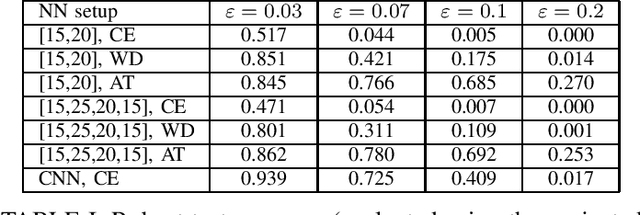

Abstract:This paper presents a new look at the neural network (NN) robustness problem, from the point of view of graph theory analysis, specifically graph curvature. Graph curvature (e.g., Ricci curvature) has been used to analyze system dynamics and identify bottlenecks in many domains, including road traffic analysis and internet routing. We define the notion of neural Ricci curvature and use it to identify bottleneck NN edges that are heavily used to ``transport data" to the NN outputs. We provide an evaluation on MNIST that illustrates that such edges indeed occur more frequently for inputs where NNs are less robust. These results will serve as the basis for an alternative method of robust training, by minimizing the number of bottleneck edges.
ICML Topological Deep Learning Challenge 2024: Beyond the Graph Domain
Sep 08, 2024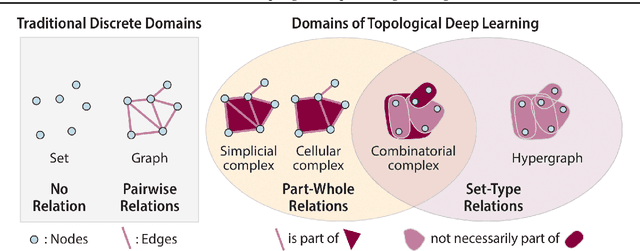
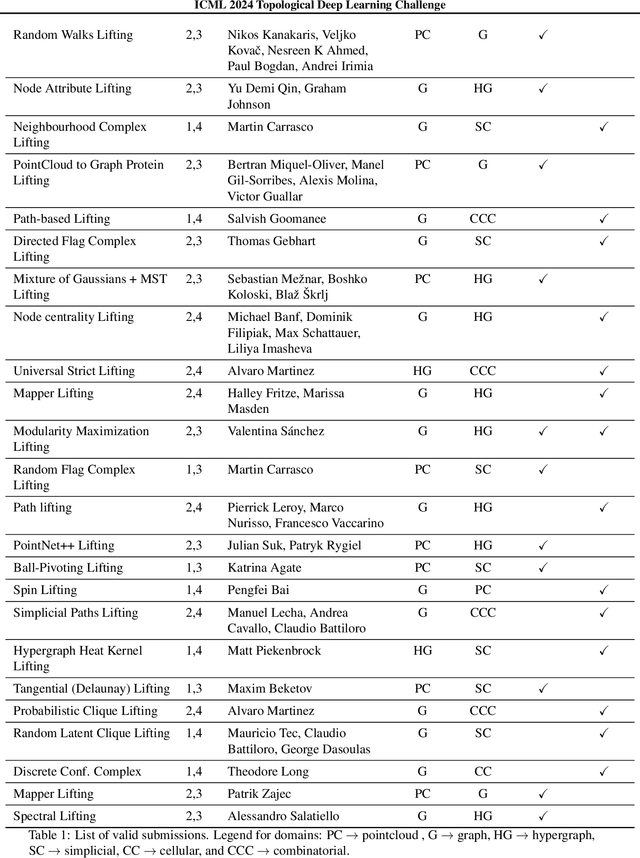
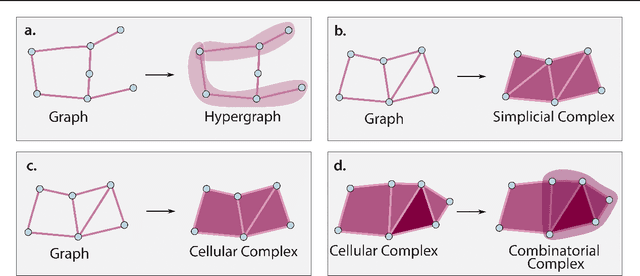
Abstract:This paper describes the 2nd edition of the ICML Topological Deep Learning Challenge that was hosted within the ICML 2024 ELLIS Workshop on Geometry-grounded Representation Learning and Generative Modeling (GRaM). The challenge focused on the problem of representing data in different discrete topological domains in order to bridge the gap between Topological Deep Learning (TDL) and other types of structured datasets (e.g. point clouds, graphs). Specifically, participants were asked to design and implement topological liftings, i.e. mappings between different data structures and topological domains --like hypergraphs, or simplicial/cell/combinatorial complexes. The challenge received 52 submissions satisfying all the requirements. This paper introduces the main scope of the challenge, and summarizes the main results and findings.
Multi-scale Conditional Generative Modeling for Microscopic Image Restoration
Jul 07, 2024



Abstract:The advance of diffusion-based generative models in recent years has revolutionized state-of-the-art (SOTA) techniques in a wide variety of image analysis and synthesis tasks, whereas their adaptation on image restoration, particularly within computational microscopy remains theoretically and empirically underexplored. In this research, we introduce a multi-scale generative model that enhances conditional image restoration through a novel exploitation of the Brownian Bridge process within wavelet domain. By initiating the Brownian Bridge diffusion process specifically at the lowest-frequency subband and applying generative adversarial networks at subsequent multi-scale high-frequency subbands in the wavelet domain, our method provides significant acceleration during training and sampling while sustaining a high image generation quality and diversity on par with SOTA diffusion models. Experimental results on various computational microscopy and imaging tasks confirm our method's robust performance and its considerable reduction in its sampling steps and time. This pioneering technique offers an efficient image restoration framework that harmonizes efficiency with quality, signifying a major stride in incorporating cutting-edge generative models into computational microscopy workflows.
Exploring Edge Probability Graph Models Beyond Edge Independency: Concepts, Analyses, and Algorithms
May 26, 2024Abstract:Desirable random graph models (RGMs) should (i) be tractable so that we can compute and control graph statistics, and (ii) generate realistic structures such as high clustering (i.e., high subgraph densities). A popular category of RGMs (e.g., Erdos-Renyi and stochastic Kronecker) outputs edge probabilities, and we need to realize (i.e., sample from) the edge probabilities to generate graphs. Typically, each edge (in)existence is assumed to be determined independently. However, with edge independency, RGMs theoretically cannot produce high subgraph densities unless they "replicate" input graphs. In this work, we explore realization beyond edge independence that can produce more realistic structures while ensuring high tractability. Specifically, we propose edge-dependent realization schemes called binding and derive closed-form tractability results on subgraph (e.g., triangle) densities in graphs generated with binding. We propose algorithms for graph generation with binding and parameter fitting of binding. We empirically validate that binding exhibits high tractability and generates realistic graphs with high clustering, significantly improving upon existing RGMs assuming edge independency.
 Add to Chrome
Add to Chrome Add to Firefox
Add to Firefox Add to Edge
Add to Edge